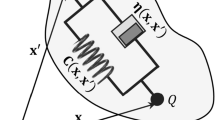Abstract
The results obtained previously for scalar and class P completely monotone relaxation moduli are extended to arbitrary anisotropy. It is shown for general anisotropic viscoelastic media that, if the relaxation modulus is a locally integrable completely monotone function, then the creep compliance is a Bernstein function and conversely. The elastic and equilibrium limits of the two material functions are related to each other. The relaxation modulus or its derivative can be singular at 0. A rigorous general formulation of the relaxation spectrum in an anisotropic viscoelastic medium is given. The effect of Newtonian viscosity on creep compliance is examined.
Similar content being viewed by others
References
Anderssen, R.S., Loy, R.J.: Rheological implications of completely monotone fading memory. J. Rheol. 46, 1459–1472 (2002)
Bernstein, B., Kearsley, E.A., Zapas, L.J.: A study of stress relaxation with finite strains. Trans. Soc. Rheol. 7, 391–410 (1963)
Bland, D.R.: The Theory of Linear Viscoelasticity. Pergamon, Oxford (1960)
Carcione, J.M., Cavallini, F., Helbig, K.: Anisotropic attenuation and material symmetry. Acustica – Acta Acustica 84, 495–502 (1996)
Desch, W., Grimmer, R.: Propagation of singularities for integrodifferential equations. J. Differ. Equ. 65, 411–426 (1965)
Fung, Y.C.: Biomechanics. Mechanical Properties of Living Tissues, 2nd edn. Springer-Verlag, New York (1993)
Gripenberg, G., Londen, S.O., Staffans, O.: Volterra Integral and Functional Equations. Cambridge University Press, Cambridge (1990)
Hanyga, A.: An anisotropic Cole–Cole model of seismic attenuation. In: Shang, E.-C., et al. (eds.) Theoretical and Computational Acoustics 2001, 319–334, World-Scientific, Singapore (2002), Proc. of the 5th International Conference on Computational and Theoretical Acoustics, Beijing, 21–25 May 2001
Hanyga, A.: Anisotropic viscoelastic models with singular memory. J. Appl. Geophys. 54, 411–425 (2003)
Hanyga, A.: Well-posedness and regularity for a class of linear thermoviscoelastic materials. Proc. R. Soc. Lond. A 459, 2281–2296 (2003)
Hanyga, A.: Physically acceptable viscoelastic models. In: Hutter, K., Wang, Y. (eds.) Trends in Applications of Mathematics to Mechanics, pp. 125–136. Shaker Verlag GmbH, Germany (2005)
Hanyga, A.: Realizable constitutive equations in linear viscoelasticity. In: Tenreiro-Machado, J.A., et al. (eds.) Fractional derivatives and their applications, Part 2: Econophysics, Mechanics, Material Modeling, Thermal Systems, Electronics, Electrical Systems, pp. 353–364, UBooks Verlag, Neusäss (2005)
Hanyga, A.: Viscous dissipation and completely monotone stress relaxation functions. Rheol. Acta 44, 614–621 (2005) doi:10.1007/s00397-005-0443-6
Hanyga, A.: Fractional-order relaxation laws in non-linear viscoelasticity. Contin. Mech. Thermodyn. (2007) doi:10.1007/s00161-007-0042-0
Hanyga, A., Seredyńska, M.: Multiple-integral viscoelastic constitutive equations. Int. J. NonLinear Mechanics (2007) doi:10.1016/j.ijnonlinmec.2007.02.003
Jurlewicz, A., Weron, K.: A relationship between asymmetric Lévy-stable distributions in dielectric susceptibility. J. Stat. Phys. 73, 69–81 (1993)
König, H., Meixner, J.: Lineare Systeme und lineare Transformationen. Math. Nachr. 19, 265–322 (1958)
Lokshin, A.A., Rok, V.E.: Automodel solutions of wave equations with time lag. Russ. Math. Surv. 33, 243–244 (1978)
Mehrabadi, M.M., Cowin, S.C.: Eigentensors of linear anisotropic materials. Quart. J. Mech. Appl. Math. 43, 15–41 (1990)
Meixner, J.: On the theory of linear passive systems. Arch. Ration. Mech. Anal. 17, 278–296 (1964)
Molinari, A.: Viscoélasticité linéaire and functions complètement monotones. J. de mécanique 12, 541–553 (1975)
Renardy, M.: Some remarks on the propagation and non-propagation of discontinuities in linearly viscoelastic liquids. Rheol. Acta 21, 251–254 (1982)
Rouse Jr, P.J.: The theory of linear viscoelastic properties of dilute solutions of coiling polymers. J. Chem. Phys. 21, 1272–1280 (1953)
Rudin, W.: Real and Complex Analysis, 3rd edn. McGraw-Hill, New York (1986)
Widder, D.V.: The Laplace Transform. Princeton University Press, Princeton (1946)
Zemanian, A.H.: Realizability Theory for Continuous Linear Systems. Academic Press, New York (1972)
Author information
Authors and Affiliations
Corresponding author
Additional information
Put some makeup on him and lay him to rest. Anonymous
Rights and permissions
About this article
Cite this article
Hanyga, A., Seredyńska, M. Relations Between Relaxation Modulus and Creep Compliance in Anisotropic Linear Viscoelasticity. J Elasticity 88, 41–61 (2007). https://doi.org/10.1007/s10659-007-9112-6
Received:
Accepted:
Published:
Issue Date:
DOI: https://doi.org/10.1007/s10659-007-9112-6
Keywords
- Linear viscoelasticity
- Anisotropy
- Relaxation
- Creep
- Completely monotone
- Bernstein function
- Material symmetry classes



